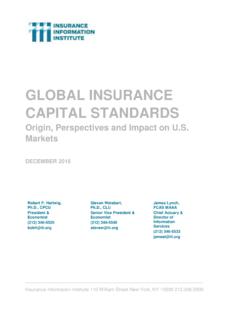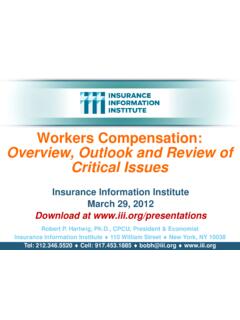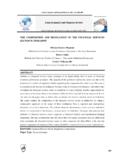Transcription of CYBER RISKS: THE GROWING THREAT
1 CYBER RISKS: THE GROWING . THREAT . JUNE 2014. Robert P. Hartwig, , CPCU. President & Economist (212) 346-5520. Claire Wilkinson Consultant (917) 459-6497. insurance Information Institute 110 William Street New York, NY. 10038 INTRODUCTION. The CYBER risk landscape is evolving rapidly in a multitude of areas. Governments are facing an unprecedented level of CYBER attacks and threats with the potential to undermine national security and critical infrastructure, while businesses that store confidential customer and client information online are fighting to maintain their reputations in the wake of massive data breaches. The potential economic fallout from the CYBER THREAT cannot be underestimated. Economic thought leaders have warned of a digital disintegration, a scenario in which cyberspace could be completely undermined due to strengthening attacks where the Internet is no longer a trusted medium for communication or commerce, at a huge cost to economies and Businesses across a wide range of industry sectors are exposed to potentially enormous physical losses as well as liabilities and costs as a result of CYBER attacks and data breaches.
2 Victims of recent attacks include such well-known brands as eBay, Target, Neiman Marcus, Michaels Stores, the University of Maryland, NATO, JPMorgan Chase, Adobe, Living Social. The list goes on. And then came the April 2014 disclosure of the Heartbleed bug which undermines the popular OpenSSL encryption technology. Many companies have said they were affected by Heartbleed and it remains to be seen how many companies will disclose data breaches as a result of this security flaw. The total number of data breaches and number of records exposed fluctuates from year to year and over time, but in 2013 the numbers soared (Fig. 1). Some 614. organizations across the business, financial, educational, government and healthcare sectors, have publicly disclosed data breaches in 2013 exposing close to 92 million records, according to the Identity Theft Resource This compares to 449 publicly disclosed data breaches during 2012, 419 during 2011, and 662.
3 Publicly disclosed data breaches in 2010. So far in 2014, some 311 data breach events have been publicly disclosed as of May 27, with million records exposed. Yet despite the large number of reported breaches, the actual number of breaches and exposed records is without a doubt much higher as many, if not most, attacks go unreported. 1. Global Risks 2014, Ninth Edition, by the World Economic Forum, 2. Identity Theft Resource Center, insurance Information Institute 2. Fig. 1. Data Breaches 2005-2013, by Number of Breaches and Records Exposed # Data Breaches/Millions of Records Exposed Millions 700 656 662 220. 614. 200. 600. 180. 498 160. 500 470. 446 140. 419. 120. 400 321 100. 80. 300. 60. 200 40. 157 20. 100 0. 2005 2006 2007 2008 2009 2010 2011 2012 2013*. # Data Breaches # Records Exposed (Millions). The Total Number of Data Breaches (+31%) and Number of Records exposed (+426%) in 2013 soared. Through May 27 this year has seen million records exposed in 311 breaches.
4 * Figures as of May 27, 2014, from the Identity Theft Resource Center, The majority of the 614 data breaches in 2013 affected business and medical/healthcare organizations, according to the Identity Theft Resource Center (Fig. 2). Fig. 2. 2013 Data Breaches By Business Category, By Number of Breaches The majority of the 614 data breaches in 2013 affected business and medical/healthcare organizations, according to the Identity Theft Resource Center. Banking/Credit/Financial, 23 ( ). Govt/Military, 56 ( ). Business, 211 ( ). Educational, 55. ( ) Medical/Healthcare, 269. ( ). Source: Identity Theft Resource Center, 3. insurance Information Institute 3. Business organizations accounted for the majority of records exposed by data breaches in 2013 (Fig. 3). Fig. 3. 2013 Data Breaches By Category, By Number of Records Exposed Business organizations accounted for the majority of records exposed by data breaches during 2013. Banking/Credit/Financial, 786,789 ( ) Govt/Military, million ( ).
5 Medical/Healthcare, million ( ). Educational, million ( ) Business, million ( ). Source: Identity Theft Resource Center, 4. In October 2011 the Securities and Exchange Commission (SEC) issued guidance urging publicly traded companies to disclose significant instances of CYBER risks and Description of relevant insurance coverage was included in the SEC's list of appropriate disclosures. This raises the important question of whether and how adequately businesses are protected by insurance coverage in the event they suffer a loss due to a CYBER attack. The rising incidence of CYBER crime targeting major companies has led to increasing momentum among government and legislative leaders to introduce substantive cybersecurity measures at the national level. Theft of military and trade secrets remains a top concern, with the in May 2014. indicting five members of the Chinese military with hacking into computer networks and engaging in CYBER espionage for a foreign government.
6 Nuclear technology developer Westinghouse was one of the entities targeted in the attack, according to the Department of Justice. 3. insurance Information Institute 4. Meanwhile, the fallout continues in the wake of former NSA contractor Edward Snowden's leaks in 2013 regarding the extent of the intelligence community's Internet surveillance. And the hacker groups known as Anonymous continue their politically motivated CYBER attacks around the world, against targets in Arab countries and in the United States, in response to publications regarding activities by the National Security Agency (NSA), drawing the attention of the FBI and other federal investigators. In February 2014, the National Institute of Standards and Technology (NIST). released a new framework for improving critical infrastructure cybersecurity. The framework gathers existing global standards and practices to help organizations understand, communicate and manage their CYBER risks.
7 The NIST release followed an executive order issued by President Obama a year earlier that promotes increased information sharing about CYBER threats between government and private companies that oversee critical infrastructure systems such as electrical grids. The Department of Homeland Security received reports of some 257 CYBER attacks on critical infrastructure systems in the in 2013, a 30 percent increase from the 197 incidents reported in A number of federal legislative/regulatory proposals on cybersecurity are under consideration by Congress. At the state level, some 47 states also have breach notification laws in effect. A summary of the executive order as well as a summary of the various legislative bills in Congress is included in Appendix 1. CYBER SECURITY: RISING CONCERNS AND COSTS. CYBER security and losses from CYBER crimes are a GROWING concern among businesses today, as highlighted in latest industry research. CYBER risk moved into the top 10 global business risks in 2014, according to the third annual Allianz Risk Barometer Survey, climbing up to rank 8 from 15 in last year's survey (Fig.)
8 4).5. The Risk Barometer, which surveyed more than 400 corporate insurance experts from 33 countries, found other interlinked emerging risks, such as loss of reputation issues and changes in legislation, were also at the forefront. Allianz noted that companies increasingly face new exposures to first- and third- party liability and business interruption from CYBER attacks or disruptions, with loss of personal data and theft of intellectual property being major concerns. 4. ICS-CERT Year in Review 2013, Department of Homeland Security. 5. Allianz Risk Barometer 2014, January 2014, insurance Information Institute 5. Fig. 4. Top 10 Global Business Risks for 2014. CYBER and reputational challenges are the most significant movers in this year's Risk Barometer rankings. CYBER moved into the top 10 global business risks for the first time. Business interruption, supply chain risk 43%. Natural catastrophes 33%. Fire, explosion 24%. Changes in legislation and regulation 21%.
9 Market stagnation or decline 19%. Loss of reputation or brand value ( from social media) 15%. Intensified competition 14%. CYBER crime, IT failures, espionage 12%. Theft, fraud, corruption 10%. Quality deficiencies, serial defects 10%. 0% 10% 20% 30% 40% 50% 60% 70% 80% 90% 100%. Source: Allianz Risk Barometer on Business Risks 2014. 5. Similarly, a May 2014 report by PWC found that while companies are focused on managing a variety of business risks, CYBER crimes are considered a high-level THREAT In a sign that organizations are taking this THREAT more seriously, the PWC survey found that the perception of the risk of cybercrime is increasing at a faster pace than that of reported actual occurrences. Some 48 percent of respondents said their perception of cybercrime risk at their organization increased in 2014, up from 39 percent in 2011 (Fig. 5). Reinforcing this evidence, PWC noted that an identical percentage (48 percent) of CEOs in its latest Global CEO Survey said they were concerned about CYBER threats, including the lack of data security.
10 6. 2014 Global Economic Crime Survey, PWC, insurance Information Institute 6. Fig. 5. PWC Survey: Perception of the Risk of Cybercrime The perception of the risk of cybercrime is increasing at a faster pace than reported actual occurrences. In 2014, some 48% of respondents said their perception of the risk of cybercrime increased, up from 39% in 2011. 2011 Global 2014 Global 48%. Increased 39%. 47%. Remained the same 57%. 4%. Decreased 4%. 0% 10% 20% 30% 40% 50% 60% 70% 80% 90% 100%. Source: 2014 Global Economic Crime Survey, PWC. 5. Overall, companies appear to have a greater understanding of the risk of cybercrime than their global peers, the survey found. PWC noted that organizations' perception of the risks of cybercrime exceeded the global average by 23 percent. Also, some 71 percent of respondents indicated their perception of the risks of cybercrime increased over the past 24 months, rising 10 percent since 2011. CYBER attacks have also become more frequent and increasingly costly for companies to resolve.






